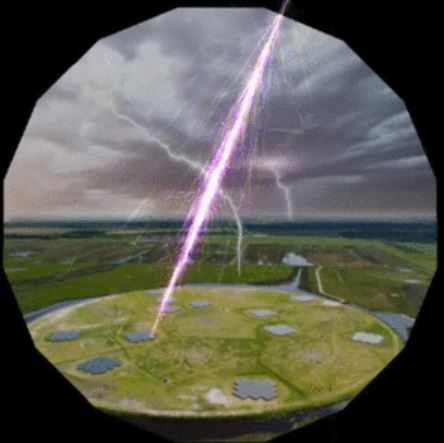Exploding stars produce cosmic rays, which could help us better understand lightning and thunderclouds on Earth, says an international team of scientists. They explained in the journal Physical Review that cosmic rays help us study lightning and thunderclouds in unprecedented detail.
It is difficult to determine how lightning is triggered in thunderclouds. Given that they are dangerous to approach, measuring their electric fields is no easy task.
The researchers, from the Netherlands, Belgium, USA, Germany, Scotland, England, Autralia, France, Japan, Russia and Finland, explained that they more or less by accident discovered that cosmic rays provide excellent probes to measure electric fields within thunderclouds.

A particle shower triggered by a cosmic ray reaches LOFAR through a thundercloud. (Image: www.cwi.nl)
They carried out the measurements using Netherland’s LOFAR radio telescope.
Professor Heino Falcke’s student Pim Schellart, who completed his PhD at Radboud University in Nijmegen, the Netherlands, in March 2015, said:
“We used to throw away LOFAR measurements taken during thunderstorms. They were too messy. Well, we didn’t actually throw them away of course, we just didn’t analyze them.”
Dr. Schellart is interested in cosmic rays – particles with immensely-high radiation that mainly originate from the supernovae of massive stars (giant exploding stars) and galactic nuclei – that are continuously bombarding Earth.
These particles strike atmospheric molecules high up in the atmosphere, creating ‘showers’ of elementary particles (particles whose substructures are unknown).
One can measure these particles from the radio emission that is generated when their constituent particles are deflected by our planet’s magnetic field.
These radio emissions also provide us with information about the original particles. These measurements are performed with LOFAR at ASTRON (Netherlands Institute for Radio Astronomy) in Dwingelloo, however, not during thunderstorms.

Thunderclouds contain massive amounts of energy.
Now they are measured during thunderstorms
That all changed when Mr. Schellart studied the data together with Prof. Olaf Scholten and Gia Trinh, both from Centrum Wiskunde & Informatica in Amsterdam.
Mr. Schellart said:
“We modeled how the electric field in thunderstorms can explain the different measurements. This worked very well.”
“How the radio emission changes gives us a lot of information about the electric fields in thunderstorms. We could even determine the strength of the electric field at a certain height in the cloud.”
This field can reach a potency of 50 kV/m (kilovolt/metre), i.e. a voltage of many hundred million volts over a distance of several kilometres. Thunderclouds contain colossal amounts of energy.
Lightning inflicts considerable damage
Lightning, which kills and injures scores of people, animals and plants every year, and inflicts damage to infrastructure, is a highly unpredictable natural phenomenon.
The authors believe their new method for measuring thunderclouds’ electric fields will give us a better understanding of their behavior, and ultimately improve our predictions of lightning activity.
Current methods of measuring thunderclouds – using airplanes, balloons and rockets – are dangerous and far too localized. The equipment itself can disrupt the measurements when it gets close to thunderclouds (which it has to).
Cosmic rays probe thunderclouds completely – from top to bottom. They move at nearly light speed and provide an almost instantaneous ‘image’ of the electric fields inside thunderclouds. They are also naturally created, abundant and freely available.
Professor Falcke said:
“This research is an exemplary form of interdisciplinary collaboration between astronomers, particle physicists and geophysicists. We hope to develop the model further to ultimately answer the question: how is lightning initiated within thunderclouds?”
Lightning expert Joseph Dwyer, of the Florida Institute of Technology, said:
“Thunderstorm electric fields have been tricky to measure, and there is a lot of uncertainty about how big the fields can get. This uncertainty, hinders an understating of how lightning gets started inside the clouds.”
“Having a technique like this to remotely measure the electric field is very useful and may help us make progress in understanding thunderstorms and lightning.”
Reference: “Probing atmospheric electric fields in thunderstorms through radio emission from cosmic-ray induced air showers,” Schellart et al. Physical Review Letters. Published 24 April, 2015. DOI: 10.1103/PhysRevLett.114.165001.

